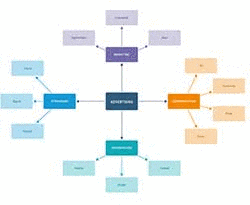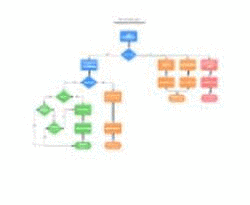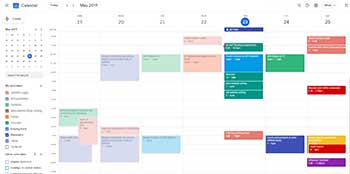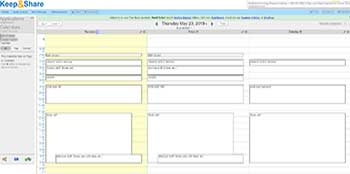Listen to this Article
Do you ever sit and think about what it’ll be like when you get old?
Nurse Bonnie Ware spent years working with patients with just a few weeks left to live. She chronicled the most common regrets people have when they get to that stage of life. The top 5 include:
- I wish I’d had the courage to live a life true to myself, not the life others expected of me.
- I wish I hadn’t spent so much time working.
- I wish I’d had the courage to express my feelings.
- I wish I had stayed in touch with my friends.
- I wish that I chose to be happier (yes, it’s a choice!)
How do you get to the end and look back with pride instead of regret?
You live intentionally.
Not tomorrow. Not next year.
Now.
Sounds easy, eh?
But what does it mean to live intentionally?
And how do you live intentionally?
SPONSORED
Obviously, living life intentionally means living according to your own choices, but there’s a wide array of subtle nuances hidden beneath the surface that you need to know about – and work on – to truly live intentionally.
An effective way to live intentionally includes these 4 steps:
- Know
- Define
- Plan
- Act & Track
First, you’re gonna need to devote some time delving into truly and honestly understanding yourself – your goals, your strengths, your weaknesses, what you’re willing to do or not do, etc.
“To know thyself is the beginning of wisdom.”
~ Socrates
We all think we know ourselves pretty well.
I mean, we’ve spent every minute with ourselves since birth, right?
You do know yourself – without a doubt.
But if you have never intentionally sat down, asked yourself the important questions, and recorded your answers on paper or in a document, you’ll surprise yourself. There’s probably a lot hidden in the uncovered recesses of the enigmatic cave of your inner psyche.

It’s imperative to dig deep, ask those tough questions, and physically record your answers. You’ll probably discover that the majority of your actions don’t match up with your core essence – who you truly are.
The goal is to know, without a doubt, who are you, what you like, what you want, what direction you want to head, what you’re willing to tolerate and what you won’t (i.e, where’s your line in the sand?), which goals you’re willing to sacrifice and sweat for and which you don’t want that badly (hint – table those!).
Of course, you’re going to change. Your goals, your preferences, your direction – life is change!
It doesn’t matter, though, because what you need to figure out are the answers to all those questions above just for right now.
Don’t wait – start now!
Here are some questions to get you started:
FREE eBOOK:
Or, use this self-reflection question generator:
Living Intentionally Questions [INTERACTIVE]
This interactive generator gives you questions to ask yourself for self-reflection to improve your ability to live intentionally every single day.
Keep clicking to get more questions.
How many people say something like this?
“I want to make lots of money, do work that doesn’t seem like work, travel the world, have 3 kids, own a Mercedes S class, and ______” (fill in the blank as you wish).
Obviously, the first problem with that kind of plan is that the goals are not SMART. (If you’re not familiar with SMART goals, here’s an overview). You need measurable goals and a concrete way to know when you’ve attained them. For example, “I want $10,000 in my Chase savings account” is measurable, and you know exactly when you’ve attained it.
We all want lots of things, but sometimes we don’t want them badly enough to put in the effort. Go through your list and make sure that your 3-5 most important goals are ones that you’re actually willing to sacrifice for. Because every worthwhile goal demands a sacrifice.
For example, for many years I was overweight. Every day, I’d say “I am going to do what it takes to start losing weight today!”.
But I HATE exercising. I dread it more than anything else. Also, I can handle about 3 weeks of eating nothing but healthy foods before I feel like I’m going to go crazy without Cheetos and pizza.
It might be a bad example, but the point is that I have to ask myself, “Do I want to lose weight badly enough to force myself to exercise and sweat 5 times a week for several months? Do I want it badly enough to eat food I don’t like and NOT eat food I do like for months? Is the price worth it for me? Can I motivate myself daily to persevere until the end?
If you want the end result but realize that you don’t want to endure the process, it’s better to be honest with yourself and table that goal for now. Otherwise, you’re setting yourself up for failure.
So, ask yourself – and be sure of your answer – “Am I honestly willing to pay the price required – day in and day out for weeks, days, months or years – in order to reach this goal?”
After you’ve tossed out the ones you really don’t want to exert too much effort on, choose the top 3 – 5 goals you want to strive for. It could be something you want to do, be, or have.
This is the beginning of your roadmap.
3. Plan: Start at the End
It’s easier and more effective to plan your course when you start at the end.
Let’s say I want $10,000 in the bank, a monthly income of $5,000, and I want to work for myself by running a successful blog.
- I first give myself a deadline: “I will have achieved these goals by Wednesday, May 22, 2024”.
- I visualize all aspects of my life on May 22, 2024. What does it mean to me when I hit those markers? What is my day like? Who is around me? What do I do during my day? If need be, I create a collage of videos or images to make it more “real”. I see it all – in detail.
- Then I analyze.I ask myself, “Is there anything else I should add to my goals list to make that reality happen by that date?”.
- Now, I work backward.
- I list the major areas I need to tackle first. Then, I break them down into smaller and smaller portions of time until I have a workable daily agenda that will successfully carry me through to the end.
This takes a few hours, at least!
Here’s an example of working backward on one (example) goal:
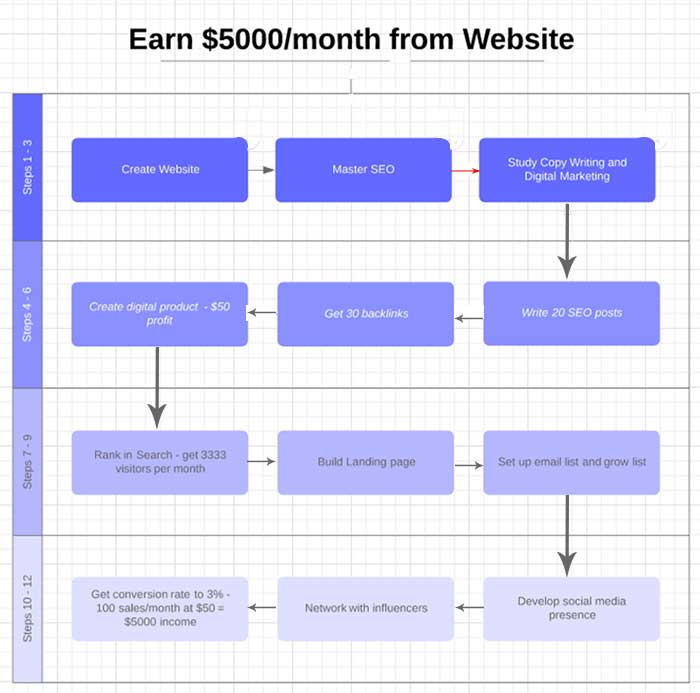
You can make your own flowchart, mind map, or strategy map at various online chart-maker sites, like:
and more.
Here are 10 Excel templates you can use, too, if you prefer that type. Save it, print it, hang it up – just don’t tuck it away, never to be seen again.
The point is to start with the end goal, break it into sub-tasks, and keep breaking it down until you get it into small, daily doable tasks.
After you’ve figured out your basic roadmap and all the sub-tasks, make a daily calendar to use as a general guide.
Life gets complicated at times, and we don’t always follow our daily agenda, eh? So just remember, this is your general, guiding map.
To make your calendar, of course, you need to estimate approximately how much time each task in your strategy map or flowchart requires. You’ll also need to know how much time you have each day to devote toward your goals.
Make your big 3 -5 goals a top priority. Work with your daily schedules to shuffle things around. Maybe you can get up 30 minutes earlier, for example.
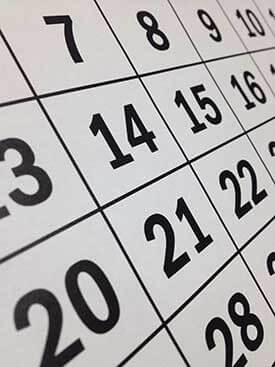
See where you can combine – are there tasks you can double up and do simultaneously? Eliminate tasks that won’t lead you to your endpoint. As always, make sure that your daily sub-tasks realistic and doable!
Also, be specific. Break your tasks down into “from 9:45 am – 10:45 am on Mondays, I will do this….” And so forth. On your calendar, set them to repeat weekly, and send yourself reminders or notifications if you need to.
I use Google Calendar and KeepandShare.com.
They’re accessible from anywhere, you can plan down to 15-minute increments, they make it easy to see your whole day, week, month, etc. at a glance, it’s easy to set up repeating events, and you can customize the heck out of them (especially Google Calendar).
4. Act & Track
To live intentionally every day, you’ve covered the first 3 steps.
You have already:
- Figured out exactly what you want to achieve in life, who you want to be, what you want to contribute and to whom, what you’ll tolerate and what you won’t, and what you want to stand for. You know.
- Made a list of the top 3 – 5 broad goals you want to work toward. You’ve listed them in specifics and broken them down into daily manageable steps. You have defined your roadmap.
- Recorded the sub-tasks of your roadmap’s 3 – 5 main targets on a daily calendar. You’ve set a completion date. You’ve weeded out the ones you’re not willing to sacrifice for. You’ve made sure your sub-tasks fit into your daily schedule.
Finally, you act and track.
There are a few obstacles to plan for, though, as you start to carry out your daily sub-tasks:
- Keeping yourself motivated to put in the effort day after day for months or years.
- Reviewing your progress and goals regularly to make adjustments to your path as situations and motivations change. Realize what works, what doesn’t, and what tasks you should keep and which ones you should discard.
- There will be obstacles. Sometimes it seems that as soon as you embark on a plan to do something, 30 things pop up immediately to derail you. Prepare ahead of time!
Make a Roadmap binder, and include 3 sections for each of these potential roadblocks.
When You Lose Motivation:
- Write a list of things you can do to keep yourself motivated when your energy and motivation wanes, as it most certainly will.
- List mantras you can chant to yourself.
- Write yourself a contract stating that when you achieve ____, you reward yourself with ___.
- Make a personal challenge for yourself and announce it publicly.
- Read stories of people who went through hell and reached a goal similar to the one you’re trying to achieve. If they can do it, so can you.
- Research at least 30 ways to get yourself re-motivated that you think would work for you, write them down, and keep that list accessible.
Keep Records, Analyze, and Re-Adjust Along the Way
Without a written record, you cannot accurately know what you’ve done, where you could improve, how far you’ve come vs how far you still have to go, what’s effective and what’s not, or even if you should work harder or lay off a bit.
My favorite tracker is the Habit Tracker 2.0. It’s easy to use, you can easily see at a glance how you’ve progressed daily, monthly, and annually. It only takes a couple minutes to update at the end of the day, too.
Of course, you can always use whatever works best for you. App-wise, I like the Strides app.
It’s important to analyze and re-adjust regularly to make course adjustments. It allows you to get to your goal faster and more efficiently. I set a quarterly email reminder on my calendar. It simply reminds me to review my progress and make adjustments at least every 3 months.
Handle Obstacles
You already know the people, situations, and events that can potentially turn into roadblocks. Does your family member make incessant demands? Does your friend get upset when you say, “I can’t right now…maybe next week?”.
Get a document with 2 columns. In the left column, write down all the known hazards and potential ones that you think might arise. In the right column, write 2 ways you can deal with it if it does occur.
Review your list every month.
Also, enlist a support buddy. If you don’t have a supportive, motivating person to hold you accountable, find one online.
This last step is definitely the hardest. We all start out gung-ho and excited. We tell everyone who’ll listen what we’re going to do and how great it’s going to be when we finish.
But 4 months in, after we’ve been slogging away all by ourselves, what happens?
We’re weary. Suddenly chilling out watching Netflix seems way more intriguing than working toward those goals. If the endpoint is years away, we lose hope that we’ll ever get there. No one understands, we stand and work alone, and we just get tired.
We start to berate ourselves. “What was I thinking?” “I can’t do this!”. “I don’t want to anymore!”. “Nobody cares, so why should I?”. We fall deeper and deeper into the “gotta give up” quagmire.
But that isn’t going to happen to you!
You thought it out.
You made a solid plan and prepared for the roadblocks.
Unlike the majority, you’re in until you reach the end.
You will succeed!
Small Steps Add Up
“Greatness is a lot of small things done well.”
The way to live intentionally seems so simple.
You know yourself and what you want. You define, plan, and act.
But, guess what?
There are all those people out there!
They want you to do this.
They want you to be that.
They “make you” feel guilty (although no one makes you feel anything but you).
They accuse you of being selfish, narcissistic, even call you a “bitch”.
Your independence may threaten them. They feel jealous, so they do everything within their power to knock you down.
Don’t give in.
Ain’t easy, for sure.
But nothing worth having is ever easy, is it?
Overcoming makes the prize more valuable, so never give in or give up.
Follow your plan.
Follow your internal compass.
You came here alone and you will leave this world alone, and this is YOUR life. It’s not anyone else’s. They have their own to live.
You don’t need anyone to understand you or support you along the way (although that’d certainly be nice, wouldn’t it?).
YOU ARE ENOUGH.
You can design the life you want and live it every single day.
Do those sub-tasks every day. Work on your emotional baggage.
Make sure that, for every tomorrow, you improve one tiny thing. That way, each day you are on the upward path.
What happens when you take one tiny step consistently? Every single day?
You grow by leaps and bounds.
One day not too far in the future, you’re living your dream life – and you did it YOUR way.
For an inspirational boost, re-listen to Frank Sinatra singing his signature song, “My Way”:
Sinatra Video
https://www.youtube.com/watch?v=3bYwKp2FJro
Your life by design created by taking one small step every day.
An intentional life is the one where you make your decisions based on what you want, value, and desire. Not on what others want or demand.
That’s how you live an intentional life.
One step and one day at a time.


